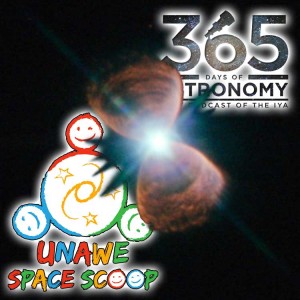Podcaster: Pamela Quevillon
Title: Cosmic Butterflies Fly in the Same Direction
Organization: Speak Easy Narration
Link : http://speakeasynarration.com ; http://www.unawe.org/kids/unawe1365/
Description: Space scoop, news for children. Today’s we bring you Sun-like stars puff away their outer layers of gas at the end of their lives. Planetary Nebula
Bio: Pamela Quevillon is a voice actress who most often lends her voice to science and science fiction content. You can find her work on the “Escape Pod” and “365 Days of Astronomy”, as well as on her site
Today’s sponsor: This episode of “365 Days of Astronomy” is sponsored by — no one. We still need sponsors for many days in 2013, so please consider sponsoring a day or two. Just click on the “Donate” button on the lower left side of this webpage, or contact us at signup@365daysofastronomy.org.
Transcript:
Cosmic Butterflies Fly in the Same Direction
 Like a last gasp of breath, Sun-like stars puff away their outer layers of gas at the end of their lives. This gas floats away into space and forms beautiful and striking clouds, which are called planetary nebulae (although they have nothing to do with planets). These clouds come in different shapes, one of which is bipolar planetary nebulae. These look like ghostly hourglasses or giant, cosmic butterflies around the remains of their parent stars.
Like a last gasp of breath, Sun-like stars puff away their outer layers of gas at the end of their lives. This gas floats away into space and forms beautiful and striking clouds, which are called planetary nebulae (although they have nothing to do with planets). These clouds come in different shapes, one of which is bipolar planetary nebulae. These look like ghostly hourglasses or giant, cosmic butterflies around the remains of their parent stars.
Planetary nebulae get their shape from their star and their surroundings, such as whether the star has planets or other stars orbiting it. The shapes of bipolar nebulae are some of the most extreme. This photograph shows why: this bipolar nebula’s parent star has powerful jets blowing material outwards from its North and South poles! The result is this fantastic and delicate butterfly-shaped cloud.
Each planetary nebula comes from a different star and they never get close enough to touch each other, so each nebula should be totally different. Yet, astronomers looking at 100 planetary nebulae in the bulging centre of our Galaxy, the Milky Way have found that most of the bipolar planetary nebulae in this region are acting in the same, strange, way. The centre of the Milky Way is a particularly busy and chaotic place, but here these nebulae are neatly lined up in the same way! They seem to be “lying down” along the disc of our Galaxy.
While the parent star does shape these nebulae, this new finding hints that there is another, more mysterious influencer: our Galaxy itself. Astronomers think the bulge at the centre of our Galaxy is acting like a giant magnet, making these bipolar planetary nebulae line up like iron filings close to a magnet.
Cool Fact: The heart of the Milky Way is crammed full of gas, dust, and stars. This is called the central bulge and it’s the reason that you can only see a small number of the enormous amount of stars in our Galaxy. There’s so much dust and gas within the bulge that you can’t even peer into it, let alone see through to the other side.
365 Days of Astronomy is a community podcast made possible thanks to the contributions of people like you. Please consider donating at 365DaysofAstronomy.org/Donate
End of podcast:
365 Days of Astronomy
=====================
The 365 Days of Astronomy Podcast is produced by the New Media Working Group of the International Year of Astronomy 2009. Audio post-production by Preston Gibson. Bandwidth donated by libsyn.com and wizzard media. Web design by Clockwork Active Media Systems. You may reproduce and distribute this audio for non-commercial purposes. Please consider supporting the podcast with a few dollars (or Euros!). Visit us on the web at 365DaysOfAstronomy.org or email us at info@365DaysOfAstronomy.org. In the new year the 365 Days of Astronomy project will be something different than before….Until then…goodbye.

